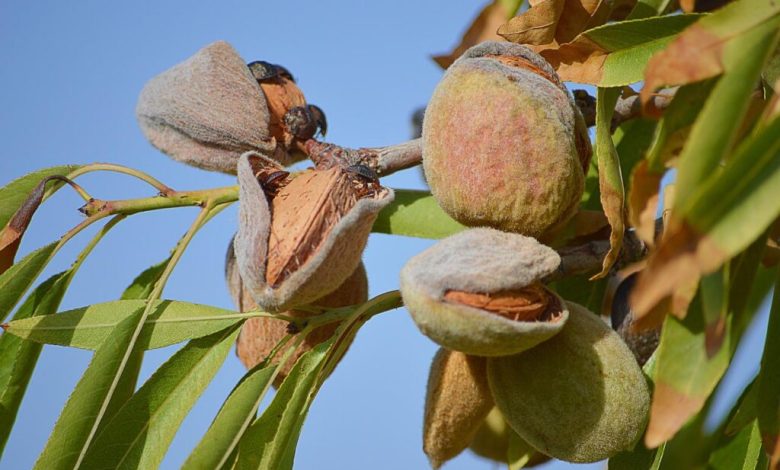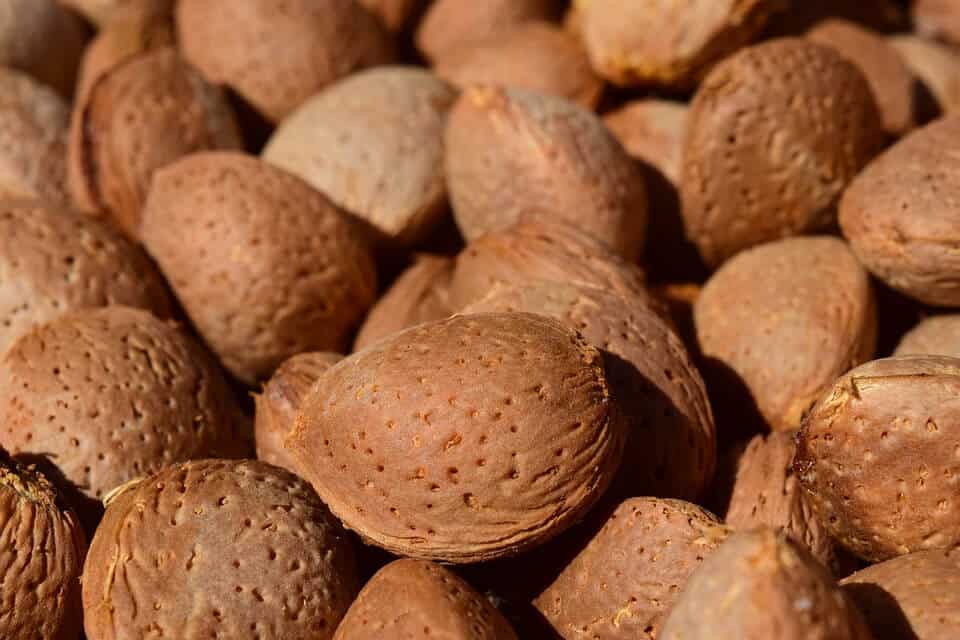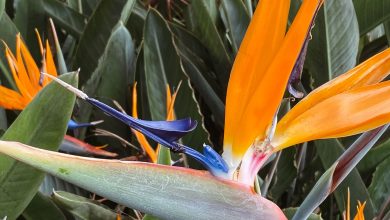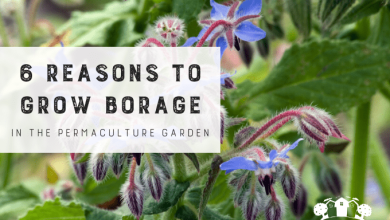Plant an Almond Tree Step by Step: [Care, Dates, Irrigation and Pruning]

Important points to plant an Almond tree:
- When? At the end of March.

- Where? Place of maximum sun exposure. Temperate climates, pulling warm.
- Harvest time? It will take about 5 years to give the first almonds.
- How do we prepare the land? Plowed, turned over and draining well. With a good contribution of organic matter. Prefers loose, sandy soils
- How do we water? Ideal, with drip irrigation. It is drought tolerant, however constant watering without flooding maximizes almond production.
- How to sow? Here step by step.
- How do we harvest? Shake the tree and collect the almonds that fall.
- Plagues and diseases? Caterpillar, tigure, defoliator moth, aphid, anthracnose.
Of all the nuts that are marketed in the world, the almond is, without a doubt, one of the most important.
Rich in antioxidants, flavonoids and phenolic compounds, the almond is very profitable compared to other nuts, due to its low production cost in comparison.
Nevertheless,its cultivation requires very demanding conditions, because if there is no suitable climate or proper care techniques, it is likely that the trees will not survive, much less bear fruit.
Therefore, here we tell you the most appropriate way to plant almond trees.
When should an almond tree be planted? The dates
Being a fruit tree, it is recommendedits sowing at the end of March.
May and early June are also a good time, since it corresponds to the time when all tree species are generally planted.
The almond tree can bloom between January and February, so it blooms under very adverse conditions (frost, rain, wind, etc.).
It bears fruit during the months of August and September.
Maybe you are also interested in:
- Pests and diseases of the almond tree.
- Properties of almonds.
- How to fertilize an almond tree.
- Different varieties and types of almonds.
- Plant an almond tree using cuttings.
Where to plant an almond tree? The ubication
 It is a fruit tree from warm areas, so it ispoorly cold tolerant, and is very drought tolerant.
It is a fruit tree from warm areas, so it ispoorly cold tolerant, and is very drought tolerant.
The lighting conditions must be total, so it is best to place it in an open field, away from any obstacle that could cause it to shade.
It demands a long period for the maturation of the fruit. Thus, if flowering takes place in January, they take up to nine months to harvest.
It requires a few cold hours for flowering, between 200 and 400.
High temperatures, as well as the absence of rain, frost and wind are very important in pollination, as it allows bees to spread pollen freely.
In this sense, bees play a fundamental role in almond cultivation.
Their temperatureoptimum growth varies between 20 and 25 ºC.
It presents damage with temperatures below -1ºC.
How often should the almond tree be watered?
 Although it is drought tolerant, a good irrigation scheme can increase its production, easily doubling it.
Although it is drought tolerant, a good irrigation scheme can increase its production, easily doubling it.
In drip irrigation, an average consumption of 3,000 m3 per hectare is estimated to achieve good production.
The period of greatest water requirements in the almond tree occurs during the 30 days in which budding, flowering, pollination and fruit set occur.
Another period that requires an increase in irrigation is the period between the start of rapid fattening of the almond and the dates on which it reaches its final length.
Except for these periods, normal watering is once a week.
How do we prepare the land for growing almond trees?
 It prefers loose, sandy soils, although they do vegetate in loams.
It prefers loose, sandy soils, although they do vegetate in loams.
Flooded and heavy soils are detrimental to it, since it does not resist root suffocation and is very susceptible to attacks by Armillaria and Phytophthora.
It is ideal that you incorporate reasonable amounts of fertilizer so that the almond tree grows more quickly and vigorously.
The ideal pH is between 5.5 and 9.0
Soil depth is recommended at least 70 cm.
Almond trees can reach up to 7 meters in height.
Keep in mind that you should plant the almond tree leaving between 5 and 7 meters away from any other tree, especially if you are going to plant two almond trees on the same piece of land.
How to plant an almond tree step by step
- Let the seed germinate. The best way to grow almond trees effectively is to germinate the seed. You can use any almond seeds, which are nothing more than dried almond fruits, still covered by their shell. Or if you prefer, you can also buy seeds from an authorized dealer.
- First, place the seeds in a deep bowl filled with water and let them soak overnight. The next day, use a nutcracker to crack open the shell a bit; although, this must still remain united, through the opening you have made you will be able to see the fruit inside.
- Discard any seeds that show signs of mold. Sow the seeds in a pot. Get a pot of at least 15 centimeters[/su_highlight] and fill it with a good potting mix, making sure it has good drainage.
- It is not necessary to use fertilizer, although if you think it is necessary, you can use mulch to give the seeds more nutrients.
- Place the seed with the opening facing up, to a depth of 2 to 5 centimeters. Finally, cover it with soil and place the pot in a closed, but well-lit place. Once the shoots have started to grow you will need to transplant them.
- Clear the ground. It extracts weeds and remains of previous crops and all kinds of residues to guarantee that your almond tree receives the adequate amount of nutrients.
- All plants must be pulled out by the roots to prevent them from growing back.
- Prepare the ground. Moisten the ground before planting; This reduces the risk of the shoots being moved by the force of the water.
- Fertilize the soil. Spread a 1-inch layer of compost on top of the soil.
- Put the seeds in the soil.
- Form a mound 5 cm high and place each shoot in the center. Pushes up to 3 cm deep. The mounds will prevent water from pooling near the roots of the plant as it grows.
- Water newly transplanted almond trees. Water them with at least a gallon of water to keep the soil well hydrated. After this initial watering, you should maintain a regular watering schedule as the tree grows.
Care that the almond tree needs
Protect the tree, especially in its beginnings
Protect the tree and give it good maintenance. Put up a chain link mesh to protect the plants while they are growing.
Regularly prune plants
Throughout the life cycle of the almond tree, we will remove the leaves in poor condition.
This is recommended to be done at the beginning of winter, since the wood of the tree is inactive and allows easy and safe removal. However, dead branches should be removed immediately at any time of the year.
To prune branches, use garden shears to make a clean cut near the base of the branch.
pollinate the flowers
If you have grown almond trees to harvest their fruits, it is necessary to pollinate the flowers.
Bees are the most common pollinators for almonds. The easiest way to promote pollination is by having multiple trees. When you have two or three trees growing together, the bees will begin to carry pollen from one tree to another.
An intense period of rains can affect pollination, since they reduce the influx of bees. If you use pesticides, make sure they don’t harm this important species.
The tart almond tree in bearing fruit: The option of grafting or almond cutting
Keep in mind that the almond tree takes up to five years before it begins to bear fruit.
The fact that you have a strong and healthy tree does not guarantee that it will bear fruit. To make sure it does, you may want to consider grafting. In other words, you must place the cutting of a tree that does bear fruit in the trunk of your tree so that they merge and become a single plant.
There are different ways to make grafts. We recommend that you consult an expert to guide you in the most effective way to do it. You will also need to make sure that both species you plan to graft are compatible.
To learn more, you can see: Almond tree cuttings.
How to harvest almonds
 The harvest of the almond depends on the state of maturation and the ease of felling and peeling.
The harvest of the almond depends on the state of maturation and the ease of felling and peeling.
The almondsthey are usually harvested between August and Octoberwhen the outer fruit has dried and opened.
Shake the tree and collect the almonds that fall.
Sometimes the fruits fall without the need to shake the trees, and although they are perfectly edible, it must be done soon before they rot.
It is recommended to freeze the nuts for 1-2 weeks to kill any residual pests.
Pests and diseases of the almond tree
Some of the most common pests and diseases that affect the almond tree are:
For more information on the pests and diseases of the Almond tree.
Caterpillar (Aglaope infausta)
It feeds on the leaves when they begin to sprout, causing them to lose strength.
For its control, oils that control the plague can be used, either during the winter or in spring when sprouting begins.
It can also be combated with Bacillus thurigiensis.
Tiger (Monosteira unicostata)
It is a very voracious hemiptera, which can spread infections in the trees, causing damage to the vegetative activity of the almond tree.
For its control, the use of traps and biological control through natural predators is recommended.
Defoliator moth (Malacosoma neustria L.)
The larvae devour the shoots and can leave them without leaves.
For its control, it is recommended to collect the eggs by hand and destroy them.
Aphids (Myzus persicae)
They attack the youngest shoots and cause deformations in the leaves. If the attack is very strong, deformations can also occur in the fruits.
For its prevention, it is recommended to apply potassium soap and neem oil.
Anthracnose (Gloesporium amygdalinum)
It is a disease of trees and plants that occurs in very humid substrates. It can cause necrosis in the body of the almond tree.
To prevent it, it is recommended to irrigate by drip or sprinklers and apply horsetail. As well as favoring the good ventilation of the tree.
More on how to plant trees:
- How to plant bamboo.
- How to plant a mango.
- How to plant an avocado tree.
- How to plant a cactus.
- How to plant a cherry tree.
- How to plant a lemon tree.
- How to plant a pistachio tree.
- How to plant a laurel.
- How to plant a hazel.
- How to plant a banana tree.
Where can I buy almond tree seeds or bushes?
As always, if you have the possibility of accessing a nursery near your town, it is the option that we recommend.
This is because you will probably be able to see the plants with your own eyes and also be advised by a professional about their care, planting or transplanting.
In any case, we can also recommend that youpurchase the seeds or plants on Amazon.Here we show you some options:
Discount!  Flower 70562 – Organic fruit fertilizer, 2 kg €13.60 €10.95 View on Amazon Prices with VAT without transport
Flower 70562 – Organic fruit fertilizer, 2 kg €13.60 €10.95 View on Amazon Prices with VAT without transport  Asklepios-seeds® – 10 Terminalia Seeds… View on Amazon Prices with VAT without transport
Asklepios-seeds® – 10 Terminalia Seeds… View on Amazon Prices with VAT without transport  Germination Seeds: Almond Tree 10 Seeds… View on Amazon Prices with VAT without transport
Germination Seeds: Almond Tree 10 Seeds… View on Amazon Prices with VAT without transport
Last updated on 08-01-2022 / Affiliate Links / Affiliate API Images
We hope that you will be able to grow an almond tree in your house and harvest its fruits in a few years. To know more, read: Varieties of almond trees.
How long does the almond tree live?
The estimated time of life for the almond tree is around 50 years.
How long does it take to grow the almond tree?
After approximately 10 years of having planted the almond tree, it will already have the texture of an adult tree.
How long does it take to produce fruit?
The most common thing is that the almond tree begins its productive task at 8 years old.
Sometimes, after two years they can begin to bear fruit, but the amount is not very representative.
Can it be grown in a pot?
It does accept planting in a pot knowing that the production will be smaller in quantity, but it does not have to affect the quality.
How many times does the almond tree produce fruit?
It is common for the almond tree to flower and produce fruit only once a year.
How cold can the almond tree tolerate?
The almond tree needs a cold winter for the development of its buds. It is advisable that the temperature is not lower than -1° C.
How many almond trees can be planted per hectare?
The approximate number of almond trees that can be planted in one hectare of land is 270 units.
This taking into account a 9 x 9 plantation frame that is beneficial for the optimal development of each specimen.
What type of fertilizer does the almond tree need?
We must work with the incorporation of macronutrients and micronutrients in all phases of cultivation.
Among the main elements are phosphorus, potassium, nitrogen, calcium, iron, sulfur, magnesium and copper.
How much heat and/or drought can the almond tree tolerate?
It is resistant to summer heat and withstands well the sudden changes generated by heat waves, accepting up to 40° C.
Above that temperature you will already be at risk of dehydration.
Do not forget that if you have any questions you can leave us a comment


![Photo of How to Plant Sweet Potatoes Step by Step [Images + Complete Guide]](https://www.complete-gardening.com/wp-content/uploads/2022/08/how-to-plant-sweet-potatoes-step-by-step-images-complete-guide-390x220.jpg)
![Photo of Caring for Indoor Flowering Plants: [Humidity, Pruning and Problems]](https://www.complete-gardening.com/wp-content/uploads/2022/08/caring-for-indoor-flowering-plants-humidity-pruning-and-problems-390x220.png)
